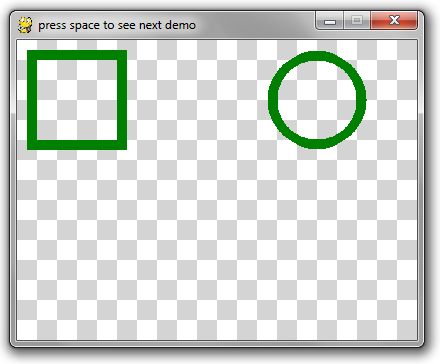

- Pygame draw dashed line for android#
- Pygame draw dashed line code#
- Pygame draw dashed line plus#
- Pygame draw dashed line mac#
Unity charges about $1,500 per developer to remove the start-up Unity splashscreen, resulting in most indie developers not paying that fee. This has resulted into a sort of stigma against Unity projects, because there is a glut of rubbish games produced by novices in Unity. Unity on the other hand is targeted towards Indie developers who want to make quick prototypes and cheap products easily. UE4 is obviously targeted towards much larger studios, who want advanced features and don’t care about built in assets etc. I feel that the trouble is their different audiences.

I have been with UE4 for 2 years, and was a paying sponsor for a year. Which is a shame, because I started with UE4 and I really wanted to like it. Overall, I guess I’ve become a unity fanboy. For example, if you want a button, your button GameObject would have a mesh, a material, a renderer (to draw the material on the mesh), a hit box (to know when the user presses it) and presumably some custom script component that runs when you hit it.Īnd because your custom scripts are written in C# or javascript, you get lovely automatically introspection on the class variables, and any variables are automatically added to the GUI! Basically, you make a fairly generic GameObject that is in your scene, and then you attach multiple components to it.
Pygame draw dashed line plus#
I really like Unity’s GameObject plus Component approach.
Pygame draw dashed line mac#
But the artists had Mac laptops that really struggled. For my beefy desktop, that was no problem.
UE4 taxed my system a lot more than Unity. Pygame draw dashed line for android#
Unity’s support for Android was much better than UE4’s. If you later want to make your own trees, it comes with a tree editor, built in! You can then start painting with that tree or grass immediately. You go to: Assets > Import Package > Terrain Assets click on the tree or grass that you want, and that’s it. Why not just have a single ‘grass’ asset that could be instantly used, and then let the user tweak it in more complicated ways if they want to later on?Ĭompare this to Unity. This was really typical of my experience with UE4. The official UE4 tutorials say that to add grass, you should import the whole 6.4 GB Open World Demo Collection to your project!īut then, even that isn’t enough because it doesn’t have any actual grass materials! You have to then create your own grass material which is quite a long process. except that you can’t because you don’t have any actual grass assets by default. You can just paint grass onto your terrain. For example, it has a lot of support for adding grass. UE4 has lots of cool features, but they are really difficult to just use. I would really love for UE4 to mix in a scripting language, like Javascript. Users who want to copy a blueprint have to do so manually, node by node. 
Someone else then has to try to decipher what is going on from a screenshot, with really no easy way to reproduce.

They’ll paste a screenshot of their blueprint saying that they have a problem.
UE4’s blueprints become particularly annoying when users are asking questions about them. Implementing a simple polynomial like $latex y = 3x^2 + 2x + 5 $ was incredibly painful in dragging out nodes for each operation.īlueprint quickly becomes a mess. But implementing in a fairly simply mathematical formula would result in 20+ nodes. I tried really hard to get on with UE4’s Blueprint, which is basically a visual “programming” language. But a mistake in C# meant just having an exception and the app being able to easily recover from it. Pygame draw dashed line code#
Mistakes in C++ code meant crashing the whole app.
I much preferred having a managed language (C# or javascript) in Unity than the C++ support in UE4. And the reasons were written up in an Internal bug report ( UE-11247 apparently) that the UE4 developers constantly refer to, but users aren’t actually allowed to view or see the status of! More annoyingly, it didn’t say why it didn’t work, it just simply disabled the Preview In VR button, giving no reason. This sucked because my artists all use Macs. UE4’s VR support simply didn’t work on a Mac. With UE4 it seemed so much more difficult. I could buy an asset and import it into my game with a couple of clicks. The Unity 5 asset store was so much nicer to use. Unity 5 was much more intuitive for me to use. But I didn’t personally use any of these advanced features. Unreal Engine 4 seems to have a lot more advanced features. I do, however, want to give some general thoughts on the comparison between them. Unfortunately these were both for clients, so I can’t talk about any specifics. I implemented two medium-sized projects, one in Unreal Engine 4 and one in Unity 5.








 0 kommentar(er)
0 kommentar(er)
